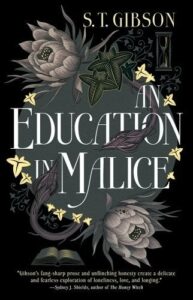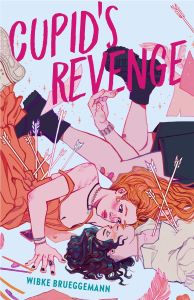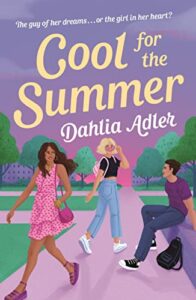Buy this from Bookshop.org to support local bookstores and the Lesbrary!
After sinking my teeth into A Dowry of Blood early last year, I was ecstatic to learn we were going to get more queer, gothic vampires from S.T. Gibson. Once again we are thrown into a sumptuous tale of power, secrets, and blood, this time set within the halls of an all-female college, Saint Perpetua’s.
Like with A Dowry of Blood, An Education in Malice is a pastiche to a landmark vampire novel, this time Sheriden Le Fanu’s Carmilla. One thing I have enjoyed about Gibson’s work is how she implements these original characters into her own spellbinding world, and this novel is no different, with the sweet Laura and enigmatic Carmilla taking place as our main protagonists.
Arriving from a small, southern town, Laura is a budding poetry student who’s come to Saint Perpetua’s to attend the highly revered poetry class headed by Miss De Lafontaine—where she meets Carmilla, an equally bright but rather callous student who is a quintessential teacher’s pet. An academic rivalry ensues, as the girls vie for De Lafontaine’s praise and approval.
Gibson once again explores power dynamics as the girls each grow closer to each other and their mysterious and alluring professor, but with a more sapphic-focused lens in comparison to A Dowry of Blood. There are themes of obsession and manipulation, but unlike Gibson’s sophomore novel, there was an all the more empathetic undertone that skewed the perspective to question the morality and judgement of each character.
We explore sex and yearning vividly through Laura’s own voice as she grapples with her sexuality, desire, and guilt. Gibson’s writing is gorgeously evocative as they pursue the depths of Laura’s attraction through intimate scenes as well as the narration throughout. One thing I love in Gibson’s novels is the inclusion of sex-positive, unashamed queerness, which makes for both a refreshing and highly enjoyable read.
An Education in Malice is filled with lush imagery and language that construct a sumptuous gothic story, amplified by the dark academic setting. Gibson’s focus on niche experiences within the context of a sapphic relationship allow for a narrative that is both overtly and complexly queer, featuring both lesbian and bisexual identifying characters, a splash of horror, and a mystery.
The only thing that left me wanting more was the plot itself, which didn’t quite live up to the excitement of A Dowry of Blood. We remain within the grounds of St. Perpetua’s for most of the narrative, which restricts the focus to the sub-plot mystery that I found lacking in intrigue.
Overall, if you enjoyed A Dowry of Blood, I would urge you to pick up An Education in Malice, as Gibson delivers another bloody, beautiful tale of queer, vampiric love.
Content Warnings: Uneven power dynamics, violence, murder, blood, consensual sexual content, substance use, homophobia (mentioned).
Lizzie is a femme non-binary (they/she) reader who loves anything weird, fantastical, and queer. You can find them predominantly on their instagram @creaturereader where they share pretty books and diverse recs.




